Have you ever looked up at a huge, beautiful full moon and tried to take a picture, only to end up with a photo of a tiny, blurry white dot? It’s a common frustration. Capturing the moon’s glowing craters and details is a lot harder than it looks.
But we promise that with the right kind of lens, you can take those incredible, detailed moon photos you’ve always wanted. You can find a lens that has the power to bring the lunar surface so close it feels like you could almost touch it.
This guide is here to help you find that perfect lens. We’ll cut through the confusing camera jargon and show you the absolute best lenses for moon photography in 2025. We’ll review options for Canon, Nikon, Sony, and more, so you can start capturing the stunning moon shots you’ve been dreaming of.
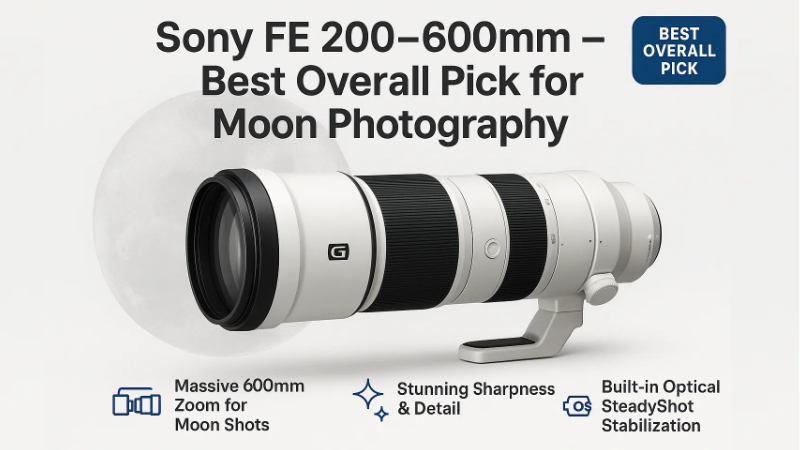
After comparing all the top telephoto lenses, the Sony FE 200-600mm f/5.6-6.3 G OSS is our clear choice for the best overall lens for moon photography.
This lens is an absolute powerhouse for capturing the moon. Its massive 600mm zoom allows you to get incredibly tight, detailed shots of the lunar surface, revealing craters and shadows with stunning clarity. You get all of this amazing reach in one lens without needing any extra accessories.
On top of its incredible zoom, it’s also extremely sharp and has fantastic built-in image stabilization (Optical SteadyShot) to help keep your photos crisp and clear.
In a hurry or already know what you’re looking for? Use the “Show” button on “Quick Navigation & Previews” below to jump straight to the section you need.
Quick Navigation & Previews
- Best Lens for Moon Photography in 2026
- How to Choose the Best Lens for Moon Photography
- Top 10 Best Lenses for Moon Photography 2026- Expert Reviewed and Tested
- 1. Canon EF 100-400mm f/4.5-5.6L IS II USM
- 2. Nikon AF-S NIKKOR 200-500mm f/5.6E ED VR
- 3. Sony FE 200-600mm f/5.6-6.3 G OSS
- 4. Sigma 150-600mm f/5-6.3 DG OS HSM Contemporary
- 5. Tamron SP 150-600mm f/5-6.3 Di VC USD G2
- 6. Canon EF 400mm f/4 DO IS II USM
- 7. Nikon Z 100-400mm f/4.5-5.6 VR S
- 8. Sony FE 100-400mm f/4.5-5.6 GM OSS
- 9. Fujifilm XF 100-400mm f/4.5-5.6 R LM OIS WR
- 10. TTArtisan 500mm f/6.3 Manual Focus Telephoto Lens
- Buyer’s Guide: What to Look for in a Moon Photography Lens
- FAQ – Moon Photography Lens Questions, Answered
- Conclusion: The Moon Is Waiting—Are You Ready to Capture It?
Best Lens for Moon Photography in 2026
Ready to see the best lenses for bringing the moon up close? To help you choose, we’ve laid out our top-rated telephoto lenses in the comparison table below. Use it to get a quick overview of the top options for your camera before we jump into the detailed reviews.
| Image | Name | Details | Price |
|---|---|---|---|
 | Canon EF IS II USM | * 100–400mm * 4-stop IS system * Professional L-series Optical * Canon EF-mount DSLRs and EOS R (compatibility) | Check Price |
 | Nikon AF-S NIKKOR ED VR | * 200–500m * 4.5-stop VR * ED glass * Nikon F-mount DSLRs (Compatibility) | Check Price |
 | Sony FE G OSS | * 200–600mm * Built-in OSS * G-series glass * Sony E-mount full-frame and APS-C (Compatibility) | Check Price |
 | Sigma DG OS HSM | * 150–600mm * Optical Stabilizer (OS) * Sharp, super-tele option * Canon EF, Nikon F, and Sigma SA mounts (Compatibility) | Check Price |
 | Tamron SP Di VC USD G2 | * 150–600mm * Powerful VC * Excellent sharpness * Canon EF and Nikon F-mount (Compatibility) | Check Price |
 | Canon EF DO IS II USM | * Prime 400mm telephoto * 4-stop IS * Lightweight DO (Diffractive Optics) * Canon EF-mount DSLRs and mirrorless (Compatibility) | Check Price |
 | Nikon Z VR S | * 100–400mm * Powerful VR * Edge-to-edge sharpness * Nikon Z-mount mirrorless (Compatibility) | Check Price |
| Sony FE GM OSS | * 100–400mm * Optical SteadyShot * Pro-grade sharpness and bokeh * Sony full-frame and APS-C E-mount (Compatibility) | Check Price |
 | Fujifilm XF R LM OIS WR | * 100–400mm * Up to 5 stops OIS * Super ED elements * Fujifilm X-mount mirrorless (Compatibility) | Check Price |
 | TTArtisan Telephoto | * Fixed 500mm * Bright f/6.3 * Manual focus only * Sony E, Canon RF, Nikon Z, Fuji X mounts (Compatibility) | Check Price |
How to Choose the Best Lens for Moon Photography
Getting a great moon photo in all about having the right tool. Here’s a simple guide to the features that really matter when choosing a lens.
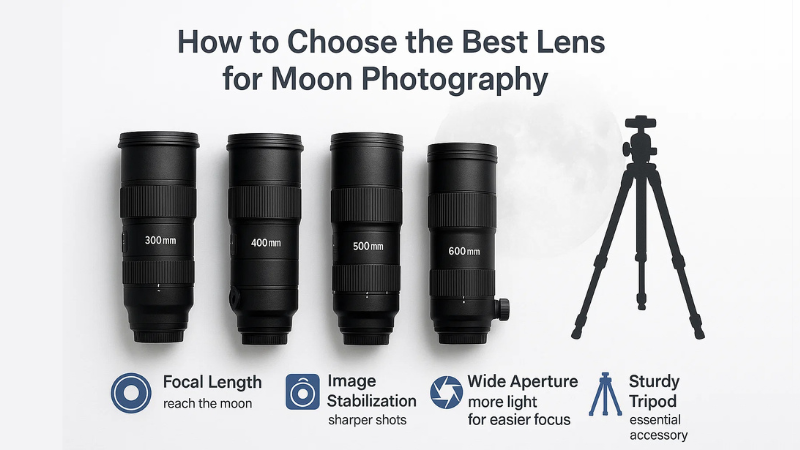
1. Focal Length (Your #1 Priority for Reach)
To make the moon look big and detailed instead of like a tiny dot, you need a lens that can zoom in a lot. This is called a “telephoto” lens.
Good: 300mm is the absolute minimum you should consider.
Better: 400mm will give you a much closer, more detailed view.
Best: 500mm or 600mm is the sweet spot for getting those amazing, frame-filling shots of the moon’s surface.
2. Image Stabilization (IS, VR, or OSS)
When you zoom in that far, even the tiniest shake of your hands will cause a blurry photo. Image stabilization is a feature built into the lens that helps to counteract that shake and keep your pictures sharp. This is an extremely important feature for moon photography.
3. Aperture Size (How Much Light it Gathers)
The aperture is the opening that lets light into the lens. A wider aperture (shown by a lower f-number like f/4 or f/5.6) is better because it lets in more light. While the moon itself is bright, a wider aperture helps the camera focus more easily in the dark and gives you more flexibility.
4. A Sturdy Tripod is Essential
This isn’t a lens feature, but it’s the most important accessory you can buy. No matter how good your lens is or how steady your hands are, putting your camera on a sturdy tripod will make the biggest difference in getting sharp, professional-looking moon photos.
Top 10 Best Lenses for Moon Photography 2026- Expert Reviewed and Tested
1. Canon EF 100-400mm f/4.5-5.6L IS II USM
Rating: 9.5/10The Canon EF 100-400mm is a legendary lens among Canon photographers, and for good reason. It’s professional-grade telephoto zoom that is know for its incredible sharpness and versatilely, making it a fantastic choice for moon photography, as well as wildlife and sports..
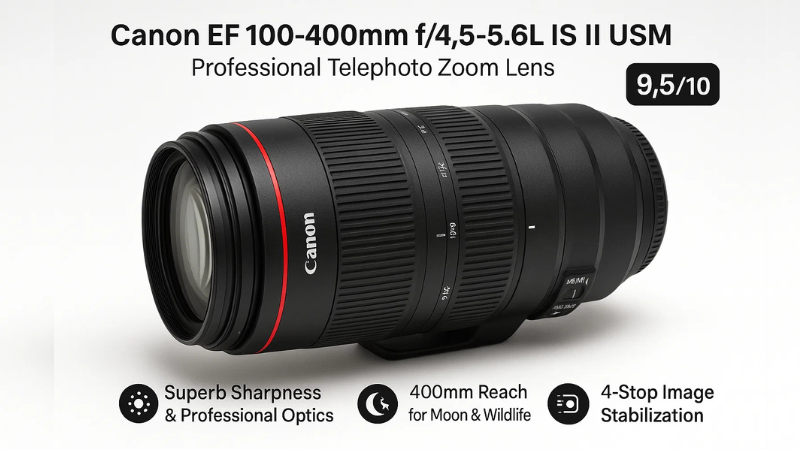
At 400mm, this lens has enough reach to get you a great, detailed shot of the moon. As a part of Canon’s professional “L-series,” its optics are superb, delivering incredibly sharp and clear images. Its 4-stop image stabilization is also highly effective, helping to reduce blur from camera shake which is critical when shooting at such long focal lengths.
This lens is built like a tank, with a rugged weather-sealed body that can handle the challenges of shooting outdoors at night. It was designed for Canon’s DSLR cameras but can be easily adapted to their newer mirrorless cameras as well, making it a great long-term investment for any Canon shooter.
| Focal Length: | 100-400 |
| Aperture: | f/4.5-5.6 |
| Mount: | Canon EF |
| Key Trait: | Professional-grade sharpness and build quality |
- Outstanding image quality across the zoom range
- Effective image stabilization
- Rugged, weather-resistant build
- On the heavier side
- Premium price
2. Nikon AF-S NIKKOR 200-500mm f/5.6E ED VR
Rating: 9.4/10This Nikon 200-500mm lens is a powerhouse that gives you incredible zoom reach without the sky-high price tag. It’s a massive favorite among wildlife and aviation photographers, and that same power makes it a fantastic and affordable choice for capturing the moon.
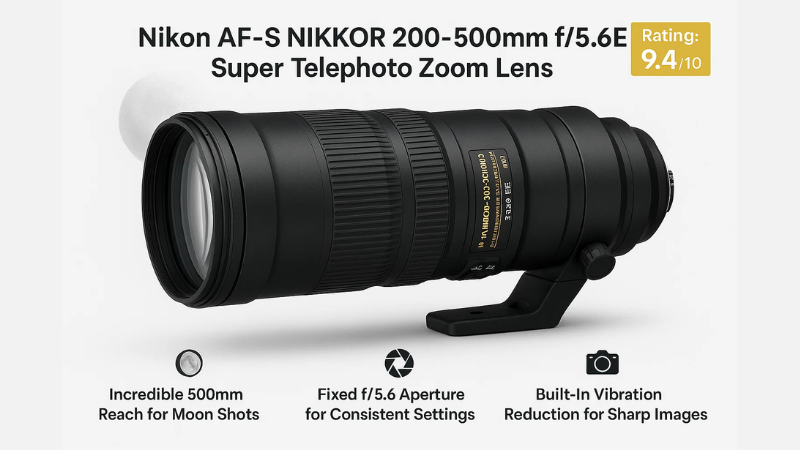
The 500mm focal length allows you to get stunning, close-up shots of the moon, filling your frame with detail. A great feature is its fixed f/5.6 maximum aperture, which means your setting won’t change as you zoom, making it easier to use. Its built in Vibration Reduction (VR) is also excellent, helping to keep your shots steady and sharp.
While it is a big and heavy lens, its image quality and reach are exceptional for the price, rivaling much more expensive lenes. This is the perfect lens for the Nikon DSLR user who wants that supper-telephoto power to get jaw-dropping moon shots but doesn’t want to empty their bank account to do it.
| Focal Length: | 200-500 |
| Aperture: | f/5.6 |
| Mount: | Nikon F |
| Key Trait: | Incredible zoom reach for an excellent price. |
t
- Exceptional zoom range
- Sharp and consistent image quality
- Great value for money
- Bulky and heavy
- Autofocus can be slower in low light
3. Sony FE 200-600mm f/5.6-6.3 G OSS
Rating: 9.6/10The Sony 200-600mm is our top overall pick, and for good reason-it’s dream lens for any Sony mirrorless photographer who is serious about moon photography. It offers a massive zoom range and professional-level sharpness in one fantastic package.
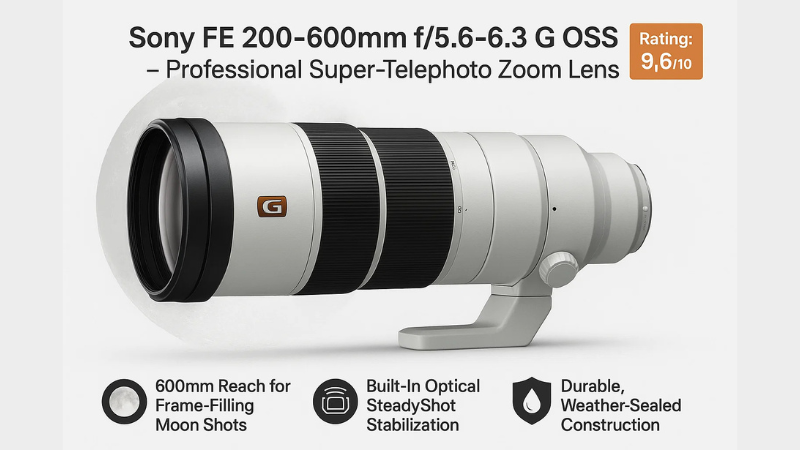
With a maximum reach of 600mm, this lens brings the moon incredibly close, letting you capture fine details like craters and ridges with amazing clarity. The image quality is crisp and sharp from one edge of the photo to the other. Its built-in Optical SteadyShot (OSS) is also incredibly effective at reducing camera shake, helping you get consistently sharp images.
This lens is built for the outdoors with a durable, weather-sealed construction. A fantastic feature is its internal zoom mechanism, which means the lens doesn’t get longer when you zoom in. This keeps it well-balanced and easy to handle on a tripod. For a Sony shooter who wants frame-filling, jaw-dropping moon shots, this lens is the ultimate tool.
| Focal Length: | 200-600 |
| Aperture: | f/5.6-6.3 |
| Mount: | Sony E Mount |
| Key Trait: | Massive 600mm reach with incredible sharpness. |
- Enormous zoom reach
- Crisp image quality even at 600mm
- Fast, quiet autofocus
- Large and heavy
- Slower aperture at full zoom
4. Sigma 150-600mm f/5-6.3 DG OS HSM Contemporary
Rating: 9.2/10The Sigma 150-600mm Contemporary is the lens that made “super-telephoto” photography accessible to everyone. It offers that massive 600mm zoom reach you need for amazing moon shots, but at a price the perfect starter lens for any aspiring moon photographer.
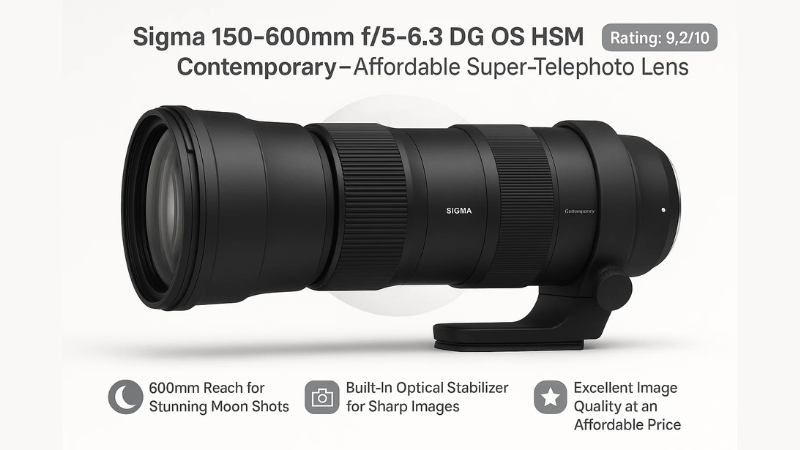
For the price, the image quality is excellent, delivering sharp and clear photos of the moon. Its built-in Optical Stabilizer (OS) does a great job of reducing camera shake, which is a must-have feature when you’re zoomed all the way in to 600mm. It gives you the power and features you need to get great result.
As part of Sigma’s “Contemporary” line, this lens was designed to be more compact and lightweight than bigger professional lenses, making it easier to carry and handle. If you’re a beginner or hobbyist who has always dreamed of getting those incredible close-up moon photos but couldn’t afford a pro lens, this is the one for you.
| Focal Length: | 150-600 |
| Aperture: | f/5.6-6.3 |
| Mount: | Canon EF, Nikon F, Sigma SA |
| Key Trait: | The best budget-friendly super telephoto lens. |
- Huge reach for the price
- Lightweight for a 600mm lens
- Affordable for long-zoom photography
- Plastic build feels less premium
- Sharpness drops slightly at max zoom
5. Tamron SP 150-600mm f/5-6.3 Di VC USD G2
Rating: 9.0/10The Tamron 150-600mm G2 is another fantastic and very popular super-telephoto lens that offers incredible reach for a great price. It’s a direct competitor to the budget Sigma lens, but it offers a more rugged build, making it a great choice for photographers who often shoot outdoors.
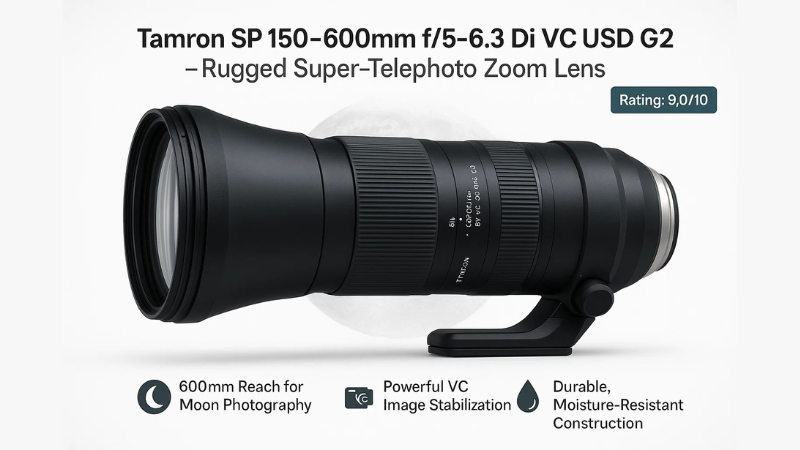
This lens is known for delivering excellent sharpness and contrast, producing beautiful, clear images of the moon. Its real standout feature is Tamron’s powerful Vibration Compensation (VC) system, which is one of the best in its class. This superior image stabilization does an amazing job of reducing camera shake, helping you get crisp, sharp photos even at 600mm.
With its durable, moisture-resistant construction, this lens is built to handle the unpredictable conditions of night photography. It’s the perfect choice for the serious hobbyist who wants that massive 600mm reach and a rugged, weather-sealed body, but still at a price that is much more affordable than pro-level Canon or Nikon lenses.
| Focal Length: | 150-600mm |
| Aperture: | f/5-6.3 |
| Mount: | Canon EF, Nikon F |
| Key Trait: | Excellent image stabilization and a durable, weather-sealed build |
- Strong stabilization system
- Durable and weather-sealed
- Excellent sharpness and contrast
- Larger and heavier than competitors
- Autofocus slightly noisy
6. Canon EF 400mm f/4 DO IS II USM
Rating: 9.1/10The Canon EF 400mm f/4 DO IS II is a special and high-performance telephoto prime lens. It’s designed for the serious photographer who wants the exceptional sharpness of a prime lens in a package that is surprisingly compact and lightweight for its power.
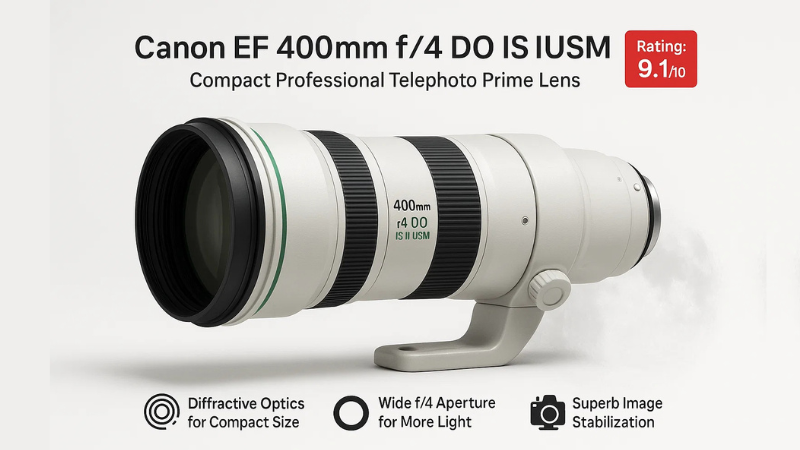
What makes this lens so unique is Canon’s special “DO” (Diffractive Optics) technology, which uses a different kind of glass to make the lens much smaller and lighter than a traditional 400mm lens. This makes it much easier to carry and handle. It also has a wider f/4 aperture, which lets in more light and can help you achieve faster shutter speeds.
Despite its smaller size, this lens delivers truly superior image quality with incredible sharpness and clarity, perfect for detailed moon shots. Its autofocus is fast and accurate, and the image stabilization is excellent. This is a premium lens for the advanced Canon user who has a big budget and wants professional results from a surprisingly portable setup.
| Focal Length: | 400mm (Prime) |
| Aperture: | f/4 |
| Mount: | Canon EF |
| Key Trait: | Lightweight and compact for a 400mm prime lens. |
- Superior image clarity
- Compact and lightweight for 400mm
- Fast, accurate autofocus
- High price tag
- Fixed focal length limits versatility
7. Nikon Z 100-400mm f/4.5-5.6 VR S
Rating: 8.9/10The Nikon Z 100-400mm is the premium, go-to telephoto zoom lens for anyone shooting with Nikon’s modern Z-mount mirrorless cameras. As part of Nikon’s top-tier “S-Line,” it’s designed to deliver the highest level of optical performance and is a fantastic choice for sharp, detailed moon photography.
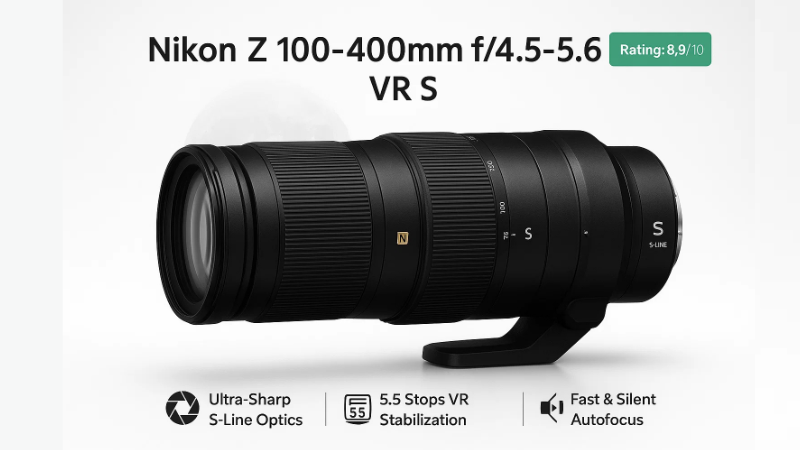
This lens is known for being incredibly sharp from the center all the way to the corners, ensuring your moon shots are crisp and full of detail. Its autofocus system is fast, silent, and accurate, which is great for locking onto the moon quickly. The built-in Vibration Reduction is also extremely powerful, providing up to 5.5 stops of correction to help eliminate any blur from camera shake.
Built for the demands of professional use, this lens has a robust, weather-sealed design to protect it from the elements during your night shoots. It’s also relatively lightweight for a lens with this much reach, making it easier to handle. For the Nikon Z-mount user who wants a native lens that delivers uncompromising image quality, this is the best option available.
| Focal Length: | 100-400mm |
| Aperture: | f/4.5-5.6 |
| Mount: | Nikon Z-Mount |
| Key Trait: | The premium, high-performance native zoom for Nikon Z cameras. |
- Excellent image quality on Z-mount
- Fast and silent focusing
- Great stabilization
- Pricey
- Not as compact
8. Sony FE 100-400mm f/4.5-5.6 GM OSS
Rating: 9.2/10This is the top-tier telephoto zoom for serious Sony mirrorless users who prioritize supreme image quality in a highly manageable and portable package. The G Master (GM) optics ensure every photo you take of the moon is crisp, clear, and perfectly detailed from edge to edge.
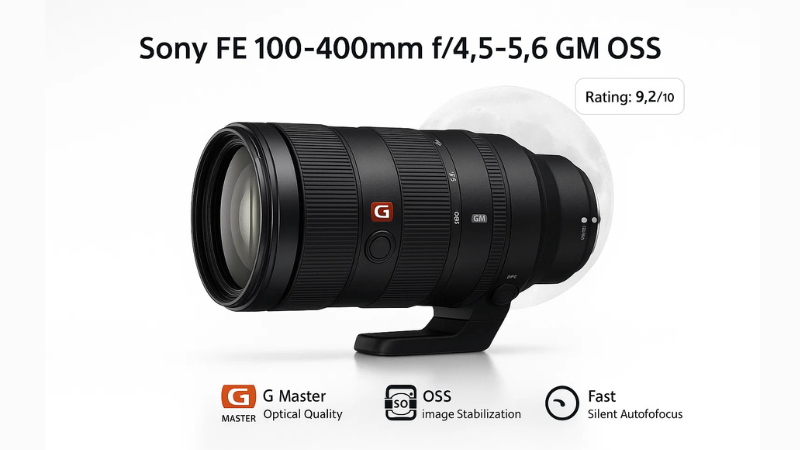
While the maximum reach is 400mm, the outstanding optical performance means your moon shots will hold up beautifully, even if you crop slightly. It features lightning-fast, silent autofocus and reliable Optical SteadyShot (OSS) stabilization, making it easy to capture sharp images of the lunar surface.
This lens is built for professional performance and is much more compact and lighter than its 600mm rivals. It’s the perfect choice for the photographer who needs a lens that is easy to hike with but still delivers uncompromising, professional-grade results.
| Focal Length: | 100-400mm |
| Aperture: | f/4.5-5.6 |
| Mount: | E-mount |
| Stabilization: | Optical SteadyShot (OSS) |
| Optics: | G Master (GM) |
- High-end G Master optics (best quality)
- Compact and lightweight for its powerful range
- Excellent autofocus performance
- Comes with a high price tag
- Shorter max zoom than 600mm rivals
9. Fujifilm XF 100-400mm f/4.5-5.6 R LM OIS WR
Rating: 8.7/10This is the must-have super-telephoto zoom lens for anyone shooting with the Fujifilm X-mount system. Since Fuji cameras use an APS-C sensor, this 100-400mm lens actually gives you an equivalent focal range of over 600mm! This is the perfect power level to capture stunning, highly detailed shots of the moon.
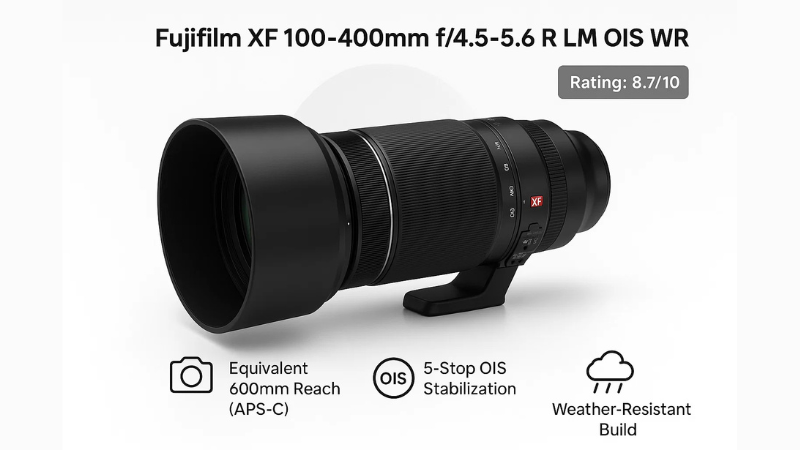
Equipped with a powerful 5.0-stop Optical Image Stabilization (OIS) system, this lens significantly minimizes camera shake. This is absolutely crucial for achieving sharp images when shooting handheld at extreme focal lengths, allowing you to work in a variety of conditions.
The lens features a twin Linear Motor (LM) for fast, quiet, and highly accurate autofocus, which is essential when tracking the moon or focusing in low light. Its weather-resistant (WR) construction protects against dust and moisture, making it a reliable lens for challenging outdoor environments.
| Focal Length: | 100-400mm |
| Aperture: | f/4.5-5.6 |
| Mount: | Fujifilm X-mount |
| Stabilization: | OIS (5.0-stop) |
| Weather Resistance: | Yes (WR) |
- Stellar 600mm equivalent reach on APS-C sensor
- Excellent, powerful stabilization system
- Fully weather-sealed and rugged build quality
- Not ideal for extremely low-light video
- Slightly heavier than other Fuji lenses
10. TTArtisan 500mm f/6.3 Manual Focus Telephoto Lens
Rating: 8.5/10The TTArtisan 500mm f/6.3 is a budget-friendly manual focus super-telephoto lens that offers incredible reach at a surprisingly accessible price point. Designed for various mirrorless and DSLR mounts, its fixed 500mm focal length is ideal for isolating distant subjects like the moon.
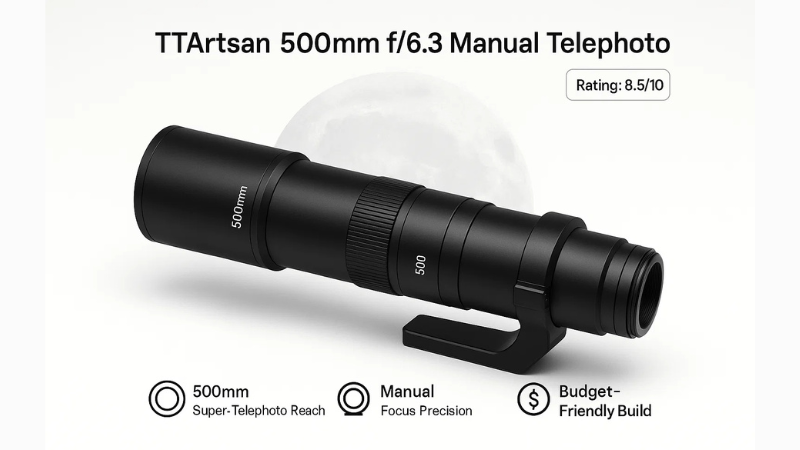
This lens is a fantastic choice for photographers on a budget who enjoy precise control over their shots. Its robust construction includes high-quality glass that helps manage color fringing and improve overall image quality for sharp lunar photos.
Built with a sturdy metal body, the TTArtisan 500mm f/6.3 includes a rotatable tripod collar for balanced mounting—a must-have since you will be focusing manually. Its relatively bright f/6.3 aperture can be advantageous, making it suitable for moon photography and distant landscapes for the truly budget-conscious photographer.
| Focal Length: | 500mm (Prime) |
| Aperture: | f/6.3 |
| Mount: | Various Mirrorless/DSLR |
| Focus Type: | Manual Focus Only |
| Build: | Metal Construction |
- Very affordable entry price point
- Relatively lightweight for a 500mm prime lens
- Compatible with most major mirrorless mounts
- Manual focus only (steep learning curve)
- No image stabilization built-in
Buyer’s Guide: What to Look for in a Moon Photography Lens
Capturing the moon’s craters, shadows, and glow isn’t just about pointing a camera skyward—it’s about choosing the right lens that brings those celestial details into focus. Here’s what to consider:
- Focal Length: For lunar photography, longer is better. A focal length of at least 300mm is recommended, but 400mm to 600mm (or more) will get you tighter, more detailed shots of the moon’s surface. If you’re using an APS-C camera, your effective focal length increases by 1.5x, which is a bonus!
- Sharpness: Not all lenses are created equal. Look for lenses with sharp center and edge performance, especially at longer focal lengths where atmospheric distortion can reduce clarity.
- Image Stabilization (IS/VR/OSS): Long telephoto lenses magnify not only the moon—but also every shake or wobble. Image stabilization helps you shoot handheld or at slower shutter speeds without blur.
- Autofocus vs Manual Focus: While autofocus is helpful, it’s not always reliable in low-light sky shots. Many astrophotographers prefer manual focus for precision. If your lens has focus peaking or a smooth focus ring, that’s a big plus.
- Weight & Portability: Super-telephoto lenses can be heavy. If you plan to hike or travel for your shots, consider a compact or lightweight option—or be sure to bring a sturdy tripod.
- Build Quality: Weather-sealed lenses are essential if you’re venturing outdoors at night, especially in humid or foggy conditions. A rugged construction ensures longevity and performance in the field.
Pro Tip: Use a tripod, remote shutter, and mirror lock-up mode (for DSLRs) to minimize vibrations and improve sharpness when photographing the moon.
FAQ – Moon Photography Lens Questions, Answered
Q: What lens size is best for photographing the moon?
A: A focal length of at least 300mm is ideal. For close-up shots with more detail, 400mm to 600mm lenses work best—especially when paired with a crop-sensor camera.
Q: Can I shoot the moon with a kit lens?
A: Yes, but you’ll only capture a small, less detailed version of the moon in the frame. A telephoto zoom or super-telephoto lens provides significantly better results.
Q: Do I need image stabilization for moon photography?
A: It’s highly recommended, especially if you’re shooting handheld. However, if you’re using a tripod, stabilization isn’t as critical and is sometimes better turned off.
Q: Is a prime or zoom lens better for moon photography?
A: Both can work well. Prime lenses typically offer better sharpness and wider apertures, while zooms provide flexibility in framing and composition.
Q: Can I use teleconverters for more reach?
A: Yes! Teleconverters can extend your focal length, but be aware they also reduce light and may impact image quality and autofocus performance.
Conclusion: The Moon Is Waiting—Are You Ready to Capture It?
With the right lens in hand, moon photography transforms from a distant curiosity into a stunning visual experience. Whether you’re a beginner with a budget-friendly manual lens or a pro using a flagship 600mm telephoto, each of the options on our list offers something unique for photographing Earth’s glowing neighbor. From Canon and Nikon to Sony, Fujifilm, and beyond, there’s a lens here that fits your gear, your skill level, and your lunar ambitions. So grab your camera, check the moon phase, and start shooting—your next breathtaking moon photo is just one click away.

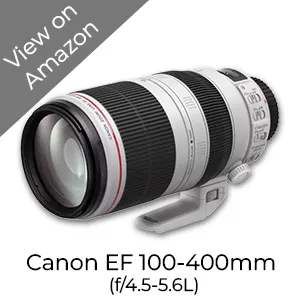
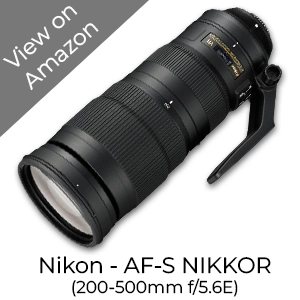
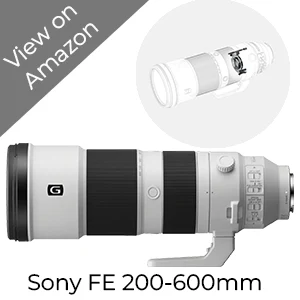
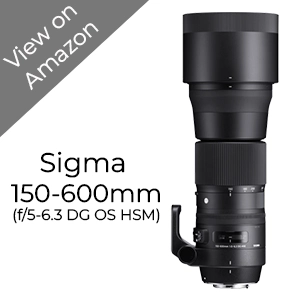
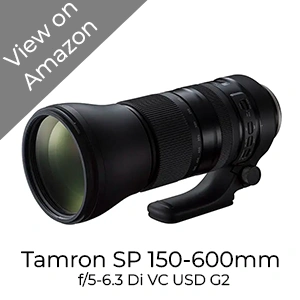
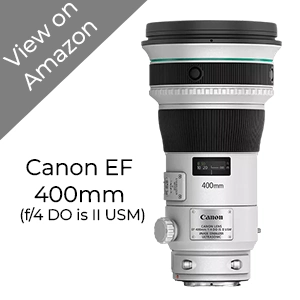
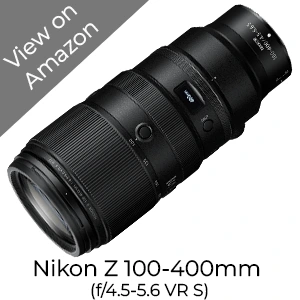
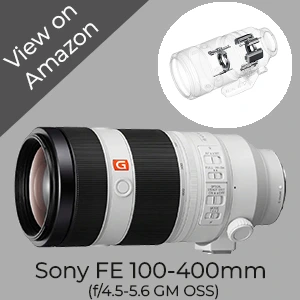

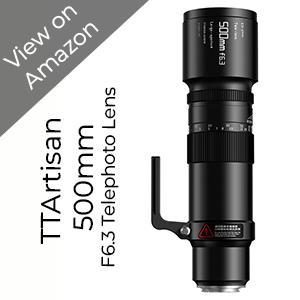
Leave a Reply